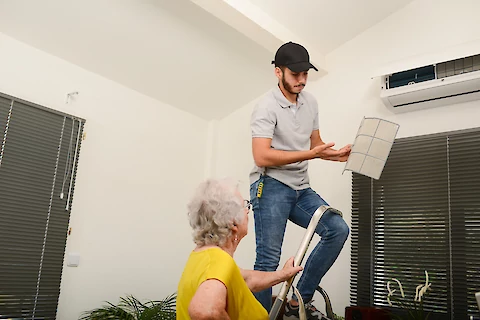
Air quality is a major concern for homes throughout the year, but the change from warm temperatures to cold conditions in the fall and winter seasons can pose some unique problems.
What Causes San Mateo's Poor Indoor Air Quality?
Air pollution can get into your home from a variety of sources, including off-gassing chemicals from furniture and carpets, household cleaning supplies, wearing sweaters with more fiber, leaky ductwork, mold growth due to increased moisture, and pressure imbalances in your home that allow outdoor contaminants to enter your living spaces from the attic.
Additionally, when the temperatures drop, we typically spend more time inside, which can reduce air circulation. Using heaters, particularly gas heaters exacerbates the situation by increasing humidity.
Preventing Poor Indoor Air Quality
You should be proactive when it comes to dealing with poor indoor air quality during winter and fall. If not kept under control, it can lead to headaches, allergic reactions, and respiratory problems, such as asthma. The following are some of the preventative measures you can employ:
1. Filtration
Enhancing the quality of your air filters in your HVAC system can aid in the removal of air pollutants as they cycle through the ductwork and back into your home. Higher filtration might alter the airflow of your HVAC system. Therefore, it's critical to have improved air filters fitted by HVAC system professionals. Effective filters enable optimal filtration of VOCs, fine dust, and viruses whilst keeping the static pressure of your AC system low to guarantee that the coolest air is supplied into your house.
2. Improving Ventilation
Mechanical ventilation is the most effective approach to providing a consistent supply of outside air into the house that you can regulate. An energy recovery ventilator (ERV) or heat recovery ventilator (HRV) draws in filtered outside air and expels stale air while managing temperature loss in the home. Simply said, you receive the advantage of clean air without increasing your energy expenditures.
3. Cleaning Your Ventilators
You may also need to clean your ventilators to improve indoor air quality. Make a cleaning schedule to ensure that your home has clean air. The EPA recommends cleaning your HVAC unit at least once a year.
4. Working on Ductwork Leaks
Holes and leakages in your ductwork may have a significant influence on your indoor air quality and dust levels in your house. This is particularly true if your ductwork has a number of pores on the return side. The return will be sucking and pulling air from the attic and pushing it through the duct system, such as your AC coil. Duct sealing rebates will aid in the sealing of duct holes and the improvement of interior air quality.
5. Insulation
Improving your home's insulation will cut your cooling and heating bills while also making it more pleasant. However, removing old insulation may help clean the air in your house. Old insulation might include mold growth due to moisture concerns or even animal feces and rodent nests.
Senior Helpers Northern Kentucky Will Help Your Loved One
Do you reside in Northern Kentucky, Florence, Edgewood, or Union and require aid in caring for your elderly relatives? Senior Helpers Northern Kentucky, a leading in-home elder care organization, offers everything from specialized care for seniors with chronic conditions, such as Alzheimer's Disease and Parkinson's Disease, to companion services for your loved ones who may require assistance with everyday tasks. Contact us today to learn more about our in-home care services.